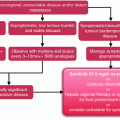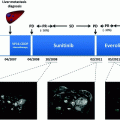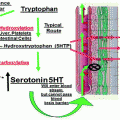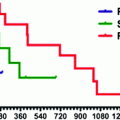Publication
Chemotherapy
Number of patients
RR (%)
PFS (months)
OS (months)
P value
For RCT for OS
Broder and Carter [1]
STZ
52
50
–
–
Moertel et al. [16]
STZ
42
36a
17
16.5
NSD
STZ + 5-FU
42
63
17
26
Eriksson et al. [9]
STZ + 5-FU
19
58a
36
–
STZ + DOX
25
36
22
–
Bukowski et al. [3]
CTZ + 5-FU
44
32a
11
25
Moertel et al. [17]
CTZ
33
30a
17
18
0.03b
STZ + 5-FU
34
45
14
16.8
0.004b
STZ + DOX
38
69
18
26.4
Cheng and Saltz [5]
STZ + DOX
16
6
–
–
Rivera and Ajani [25]
STZ + 5-FU + DOX
11
55
15
21
Kouvaraki et al. [12]
STZ + 5-FU + DOX
84
39
18
37
McCollum et al. [14]
STZ + DOX
16
6
3.9
20
Delaunoit et al. [7]
STZ + DOX
45
36
16
24
Fjallskog et al. [10]
STZ + DOX (L)
30
40
13
52
Turner et al. [28]
5FU/CIS/STZ
49
38
–
–
Subsequently, there have been a number of retrospective case series that have applied conventional radiological response criteria, including WHO and Response Evaluation Criteria in Solid Tumours (RECIST) criteria [27], with variable outcomes. Two small studies initially questioned the high response rates reported in the Moertel studies: Cheng et al. reviewed the outcome of 16 patients who had received the DOX/STZ over a 6 year period at Memorial Sloan-Kettering Cancer Centre. Duration of treatment ranged from 1.5–18 months. Applying WHO response criteria, only 6 % achieved a partial response, 56 % had SD and 38 % had PD [5]. Similarly, McCollum et al. carried out a multicentre retrospective review of 16 patients with PNETs who had received the DOX-STZ regimen. According to the RECIST criteria, 6 % had a PR, 38 % had SD as their best response and 56 % had PD. The median progression-free survival (PFS) was 3.9 months (95 % CI 2.8–8.8 months), and median OS was 20.2 months, which was thought to be more a reflection of the indolent nature of PNETs rather than as a result of the chemotherapeutic regimen [14]. More recently, three larger retrospective series have reported more encouraging activity for STZ-based combinations. Delaunoit et al. carried out a review of 45 consecutive patients with PNETs treated with the DOX–STZ regimen. According to WHO criteria, 36 % achieved a PR, 16 % had a MR, 9 % had SD and 40 % had PD [7]. Patients treated with DOX/STZ first-line had a median survival of 22.4 months compared with 5.5 months for patients previously treated with chemotherapy (P = 0.013). Fjallskog et al. also reported a response rate of 40 % in 30 patients treated with STZ and a liposomal formulation of DOX [10].
STZ-based combinations using three drug regimens have also produced encouraging results. Kouvaraki et al. reported the outcome for 84 patients with PNETs treated with the 4 weekly FAS regimen (5FU 400 mg/m2 D1-5, STZ 400 mg/m2 D1-5 and DOX 400 mg/m2 [12]. The response rate was 39 % while 50 % had SD and 11 % had PD. Four responding patients were able to have curative resection. The median duration of response was 9.3 months, and the median time to response (TTR) was 3.9 months. None of the 11 patients with metastatic gastrinomas responded to chemotherapy, compared with 45 % (33/73) of patients with all other tumour types. Overall, median PFS and OS were 18 and 37 months, respectively. The extent of liver disease (>75 %) was significantly associated with a shorter PFS and OS. Most recently, Turner et al reviewed outcome for patients treated with the FCiSt combination (5-FU 500 mg/m2, STZ 1 g/m2 and cisplatin 70 mg/m2) given on D1 of a 21 day cycle. Where glomerular filtration rate (GFR) was less than 60 ml/min cisplatin was substituted with carboplatin AUC 5 mg/ml/min. Of 47 evaluable patients with PNETs, 38 % had a PR, 51 % had SD and 11 % had PD. The median TTR was 20 weeks [28].
In summary, for PNETs, there is evidence from randomised trials that combination of STZ-based chemotherapy is associated improved survival and response rates from recent retrospective series applying WHO or RECIST criteria are in the region of 30–40 %.
Chemotherapy for Non-Pancreatic NETs
The first randomised trial exploring STZ in metastatic NP-NETs was reported by Moertel and Hanely in 1979 [15] (Table 5.2). In this study, the combination of STZ with 5FU or cyclophosphamide was compared and response rates of 44 and 37 %, respectively, were reported among the mid-gut NETs using combined radiological or biochemical criteria. Two further randomised trials have been undertaken in this group. The first study reported the outcome of EST 5275 Eastern Cooperative Oncology Group (ECOG) trial that recruited 210 patients between 1976 and 1981. In an attempt to reduce the toxicity, a less intensive 10 week cycle was used for the combination of 5FU/STZ (5FU 400 mg/m2 D1-5 and D36-40, STZ 500 mg/m2 D1-5) and DOX was administered at 60 mg/m2 D1, 22, 43 and 4 weekly thereafter. Of 161 patients treated first-line, the response rate for the 5FU/STZ combination was 22 % and for DOX was 21 % using radiological, clinical or biochemical criteria. Two patients on the 5-FU/STZ arm died following myelosuppression, and 2 patients treated with DOX died of heart failure. One patient also died of renal failure having received a total of 43.2 g STZ. Median OS was 48 weeks for DOX and 64 weeks for 5-FU/STZ but the difference was not significant. Since the median duration of response was short (26 and 31 weeks for DOX and 5-FU/STZ, respectively) and there were only 3 cases of CR, the authors felt that neither regimen should be considered as standard therapy for ‘carcinoid’ tumours.
Table 5.2
Outcomes for streptozocin-containing regimens in non-pancreatic NETs
Publication | Chemotherapy | Number of patients | RR (%) | PFS (months) | OS (months) | P value For RCT for OS |
|---|---|---|---|---|---|---|
Moertel and Hanley [15] | STZ + 5-FU | 42 | 33a | – | – | |
STZ + C | 47 | 26 | – | – | ||
Engstrom et al. [8] | STZ + 5-FU | 86 | 22a | – | 14.7 | NSD |
DOX | 86 | 21 | – | 11.1 | ||
Oberg et al. [20] | STZ + 5-FU | 24 | 8a | – | 18 | |
Bukowski et al. [2] | FAC-S | 56 | 31a | – | 12.9 | |
FC-S | 9 | 22 | – | 7.6 | ||
Sun et al. [26] | DOX + 5-FU | 85 | 16 | 4.7 | 15.7 | 0.0267 |
STZ + 5-FU | 78 | 16 | 4.8 | 24.3 | ||
Dahan et al. [6] | STZ + 5-FU | 32 | 3 | 5.5 | 30.4 | 0.83
Stay updated, free articles. Join our Telegram channel
Full access? Get Clinical Tree
 Get Clinical Tree app for offline access
Get Clinical Tree app for offline access

|




